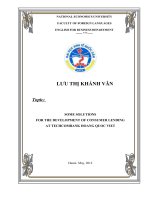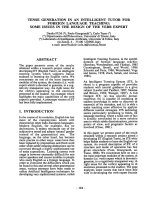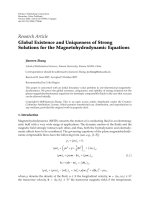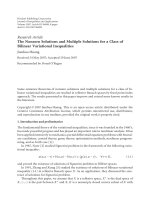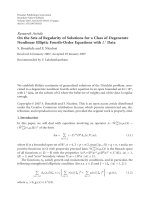Internship Report - some solutions for the enhancement of household production lending activities at agribank – son dong branch
Bạn đang xem bản rút gọn của tài liệu. Xem và tải ngay bản đầy đủ của tài liệu tại đây (234.03 KB, 24 trang )
PREFACE
In our economy today, household production economy accounts for a very important
position, and its potential growth is also very large. To expand the scale of production
and innovate the equipment as well as engage in economic relations, the producers
definitely need capital. However, their own sources of capital are very limited, while
accessing to the banks’ capital still meets many barriers. These facts has reduced the
effectiveness of exploiting the potential of household production economy.
From the actual situation at the local and the overall development strategy of
banking sector, the Vietnam Bank for Agriculture and Rural Development – Son Dong
Branch has determined its long-term goals in the rural agricultural markets, and
economic sectors mainly are household production units. However, in reality the
expansion of lending to households is increasingly difficult due to small loans and high
cost operations. Therefore, extending households lending must be accompanied by
improving quality and security in the operation of bank credit. If so, the business of
banking would actually become a leverage to promote economic development.
Starting from the arguments and actual examination of loans to producers at the
AGRIBANK - Son Dong Branch, the writer have decided to choose the topic "SOME
SOLUTIONS FOR THE ENHANCEMENT OF HOUSEHOLD PRODUCTION
LENDING ACTIVITIES AT AGRIBANK – SON DONG BRANCH" as the subject for
this internship report.
The structure of this report is designed in three parts:
Part 1: Introduction of Agribank and Son Dong Branch
Part 2: Evaluating the effectiveness of household production lending at the branch
Part 3: Recommendations and Conclusion
In this paper, the writer would like to send great thanks to MA. Dinh Hoang Minh
who has given useful guidance and valuable suggestions for the writer; to Ms. Thuy, Mr.
1
Lanh, Ms. Ha and Ms. Hien who directly instructed the writer for their gracious help of
creating opportunities and good conditions for the writer to take part in practical
activities during internship period.
However, owing to the writer’s lack of experience and knowledge as well as the
limited scope of the research, some shortcomings and mistakes are unavoidable. Please
kindly take into account.
2
LIST OF ABBREVIATION
Abbreviation Meaning
Agribank Vietnam Bank for Agriculture and Rural Development
ASDB Agribank’s Son Dong Branch
SBV State Bank of Vietnam
ABIC Agriculture Bank Insurance Joint Stock Corporation
VBA Vietnam Bank for Agriculture
LIST OF TABLES AND DIAGRAM
Table 1.1 Fundamental information of Vietnam Bank for Agriculture and Rural
Development………………………………………………………………………… p.08
Table 1.2 Agribank’s business volume as of October 2013………………………… p.10
Diagram 1.1 Organizational structure of Agribank’s Son Dong Branch…………… p.12
Diagram 2.1 Loans structure at Agribank’s Son Dong Branch according to economic
sectors in 2011, 2012 and 2013……………………………………………………… p.14
Table 2.1 Debts structure by groups at Agribank’s Son Dong Branch from 2011 to
2013……………………………………………………………………………… p.15
3
INTERNSHIP DIARY
4
5
Date Tasks
Week 1 (July, 1
st
– July, 4
th
) Appraisal Process
1 - Learnt about Son Dong Branch’s organizational structure
and working environment.
- Learnt how to scan B/W or color, use photocopy machine
2 - Learnt about the process of appraisal and approving a loan
at the branch.
- Observed Mr. Lanh guided customers’ how to prepare a
full set of loan documentations and made a minute of hand-
over documents for customers.
3 - Read legal regulations of government which are related to
credit activities.
- Presented 1 documents to be signed by the Head of
Business Development and Planning Department.
4 - Wrote several application form in loans documents for
customers.
- Read the Decision No. 666/QĐ-HĐQT-TDHO of the
Agribank Board of Director about lending provisions for
customers in the banking system of Agribank.
Week 2 ( July, 7
th
– July, 11
th
) Loans Documents
7 - Double – checked to see whether all important information
in credit agreement and certificate of land use are exactly
matched.
- Arranged credit documents (application for loans, credit
insurance application and other important administrative
papers)
- Photocopy documents
8 - Double - checked documents upon 2 criteria: accuracy
(including red stamp and authentic signature) and
adequacy.
- Observed Mr. Lanh checked customer’s account balance
- Presented credit documents to be signed initially by the
Head of Business Development and Planning Department
and then by General Director of the branch.
9 - Scanned black and white payment orders for storage in
database
- Arranged documents
- Double – checked to see whether all important information
in credit agreement and certificate of land use are exactly
matched.
10 - Presented credit documents to be signed initially by the
6
1 - INTRODUCTION OF AGRIBANK – SON DONG BRANCH
1.1 Introduction of Agribank
1.1.1 Fundamental information
Table 1.1 Fundamental information of Vietnam Bank for Agriculture and Rural
Development
Bank’s name Ngân hàng Nông nghiệp và Phát triển Nông thôn Việt
Nam
Bank’s name in English Vietnam Bank for Agriculture and Rural Development
Name abbreviation AGRIBANK
Logo
Chartered capital VND 29,605 billion (as of October 2013)
Headquarters No. 18 Tran Huu Duc street, My Dinh, Tu Liem, Hanoi
Telephone (84 – 4) 8313717
Fax (84 – 4) 8313719
Website
(Source: www.agribank.com.vn)
1.1.2 Agribank's milestones in development
1988: Established under the name of Agricultural development Bank of Viet Nam
by decree No. 53/HDBT dated 26 March, 1988 of the Council of Ministers (now the
Government).
7
1990: Changed name to Vietnam Bank for Agriculture (VBA)
1991: Established the representative office of Vietnam bank for Agricultural in Ho
Chi Minh City.
1992: established VBA provincial branches.
1994: Approved new innovative management system model of the Agribank and
began to be organized into a State-owned Corporation.
1996: Changed name to Vietnam Bank for Agriculture and Rural Development
(AGRIBANK)
2001-2010: Implemented the plan of bank restructuring.
2001: Became the leading commercial bank in Vietnam, with the most extensive
network of branches in rural areas.
2002: Became a member of APRACA and the Confederation International du Credit
Agricole (CICA).
2009: Utilized modern information technology to develop and introduce modern
banking products and services, payment connectivity with the State Treasury, in
coordination with Taxation and Customs Offices for the collection of state budget;
2010: Be in Top 10 of 500 largest enterprises in Vietnam and continuously to be the
largest Financial Institution in Vietnam.
2011: Completely changed into Ltd company with 100% capital of state and became
the leading credit institution for pilot lending for the new rural construction
2012: Won the title such as: Top 10 biggest enterprises in Vietnam – VNR500; Top
ASEAN Enterprise, Top brand name of ASEAN; Top Bank for Payment; Top Banks of
Vietnam.
2013: Held the 25 year universal (March 26, 1988 – March 26, 2013)
8
1.1.3 Business volume
Table 1.2 Agribank’s business volume as of October 2013 (VND billion)
Total asset 671,846
Total fund resource 593,648
Equity 29,605
Total outstanding loans 523,088
(Source: www.agribank.com.vn)
Agribank is also the largest bank in Viet Nam in terms of workforce, operating
network and customer base. As of October 2013, the operating network of Agribank
includes 2,400 branches and transaction offices nationwide which is operated by 40,000
staffs.
1.2 Overview of Son Dong Branch
Vietnam Bank for Agriculture and Rural Development – Son Dong Branch was
established in 26
th
March, 1988 to perform two main functions including state
management and trading currency.
Agribank’s Son Dong Branch is a class III branch under the control of the Bank for
Agriculture and Rural Development in Bacgiang. Right from the beginning of its
operation, though was difficult due to the lack of manpower and facilities, but the
leadership and staff of the branch has made great efforts to achieve good results and
significant contributions to the development of Agribank. Getting through the crucible of
the market economy, ASDB has stood firm and always played a major role in the
financial market of rural credit in Son Dong.
1.2.1 Main products and services
9
Accounts and deposits: accepting deposits and mobilizing savings with the
diver, attractive interest rates such as promissory notes, bonds, certificates of
deposit
Loans: lending in short, medium or long term, daily life consumption,
investment trusts; mortgage lending by valuable papers, co-sponsored loans,
lending by issuing credit cards
Guarantee: implementing businesses; payment guarantees; bid guarantee;
contract performance guarantee, contract of guarantee, guarantee confirmation.
Domestic payment services: domestic money transfer services, service of
collection and payments; state budget collection services, bill payment services,
automatic collection services…
Foreign Exchange Services: cash transfer; foreign currency trading; remittance
payment; currency exchange…
Border payment with Laos: including bank drafts, cross-border money transfers
documents, trading transaction payment, deed of trust and e-transfers, letters of
credit and letters of trade border payment guarantee letter.
Card Services: issuing domestic debit card (success); international debit card
(master/visa debit); International credit cards (Master/Visa credit); business card
set.
Electronic banking (e-banking): mobile banking services (VnTopup - phone
recharging services via SMS, SMS banking; Atransfer – SMS money transfer
service); VnMart services, internet banking; Apaybill
Insurance: Security credit insurance; Insurance for international cardholders,
cargo insurance, fire insurance; insurance of automobiles, motorcycle, human;
other kinds of insurance.
Other services: provide account information; automatic salaries paying and
receiving service; safe leasing services; consulting services and other services
1.2.2 Organizational structure
By the end of July 2014, the total number of employees in ASDB has reached 35. Its
organizational structure includes 2 departments and 2 transaction offices, which is
depicted as the following chart:
10
Diagram 1.1 Organizational structure of Agribank’s Son Dong Branch
(Source: Agribank’s Son Dong Branch)
2 - EVALUATING THE EFFECTIVENESS OF HOUSEHOLD
PRODUCTION LENDING AT THE BRANCH
2.1 Current situation
2.1.1 Qualitative criteria
Market share and develop the market:
Developing the market at the branch currently faces several difficulties since the
market share of ASDB decreases slightly. According to the income statement of ASDB
for the year 2013, the market share of fund resources in 2013 was 73,0%, which
decreased by 2,4% in comparing with 2012’s figure. It can be due to the fact that interest
rates of other credit unions are more attractive to customers. However, the market share in
households lending market is stable and even increase lightly. In 2013, loans for
11
production households of ASDB accounts for 45,4% of total market, which increased by
3,2% in comparing with the previous year.
In order to hold firm and develop the market share of the branch, ASDB has
applied several solutions as: investing in modern technology equipment which is used to
serve the loan business and other banking operations; expanding the products and services
provided; educating and disseminating the professional ethics, working behavior, which
follow strictly the Agribank Culture, to all personnel in the office in order to serve the
customers the best.
The implementation of the lending process:
In general lending activities and loan production households in particular, ASDB
complies all the processes and procedures of the Vietnam Bank for Agriculture and Rural
Development. Besides, ASDB continually improves the quality of loans and keeps close
control of these loans. ASDB also pay more attention to new projects which help
restructure crop plants, domestic animal in accordance with the direction of commodities
in agriculture – rural field. Loans for timber planting for paper production; cattle-
breeding… for example.
The level of accuracy in evaluating the production households lending:
Debt group 2 with potential risks is relatively high, then the evaluation of loans for
production households of ASDB has not been highly appreciated. The appraisal and
inspection before, during and after the lending are not being able to detect customers’
errors.
The ability to increase the prestige of the bank:
Meanwhile the demand for loans by households is in an increasing trend, the
reputation of ASDB has been also reinforced significantly helping raise the number of
borrowers who are production households.
2.1.2 Quantitative criteria
12
Proportion of loans for households in total loans
Diagram 2.1 Loans structure at Agribank’s Son Dong Branch according to economic
sectors in 2011, 2012 and 2013
From the above charts, it is clearly seen that loan sales for households always
account for a large part in total loan sales of ASDB. Proportion of households lending in
2013 was 68.28%, which indicated a growth rate of 2.43% in comparing with the
previous year. These figures reflect an improvement in quality of loans for production
household. Therefore, not only the number of households lending but also total loan sales
has increased remarkably.
Bad debts:
Table 2.1 Debts structure by groups at Agribank’s Son Dong Branch
from 2011 to 2013
Unit: million VND
13
Debt Groups Year 2011 Year 2012 Year 2013
Group 1 187.598 230.415 285.146
Group 2 41.189 30.668 22.061
Group 3 1.492 1.730 543
Group 4 877 665 412
Group 5 969 210 481
(Source: Telegraphy from Administrative Department of Agribank’s Bac Giang Province)
Bad debts include debts which belong to group 3, 4 and 5. Therefore, the figures
for bad debts in 2011, 2012 and 2013 at ASDB were 3.338 million VND, 2.605 million
VND and 1.436 VND respectively. Obviously, bad debts at ASDB has decreased
significantly in recent years. In order to achieve this good result, general director of
ASDB has directed the staffs to keep close control of loans for households and make sure
that lending work is conducted effectively.
Effectiveness of households lending activities is also evaluated by the ratio of bad
debts to total outstanding balance. This ratio was 1.44% in 2011, then has decreased
gradually in the following years to 0.99% in 2012 and 0.47% in 2013. With this level of
bad debts, ASDB is assessed to be relatively effective in operation in general and in
households lending in particular.
Credit Efficiency target (H):
This indicator is calculated as the ratio of the interests earned from households
lending to total outstanding balance of households production. In 2011, H = 0.16; in 2012,
H = 0.17 and H= 0.19 in 2013. It can be seen clearly that loans for production households
at ASDB has improved in a positive direction. To be more specific, in 2011 with each
VND the bank lends out, it will be able to collect 0.16 VND for the interest. However, in
14
2012 this figure has been enhanced to 0.17 VND and till 2013 the bank can earn 0.19
VND by lending out 1 VND.
2.2 Evaluating the effectiveness of loans for households
2.2.1 Achievements
As illustrated by the data and tables in the previous section, the growth rate of
outstanding balance and bad debts ratio are less than 3% and decrease continuously over
recent years. The ratio of bad debts to total outstanding balance was even less than 1% in
2013. These figures reveal a significant enhancement in the quality of household lendings
at ASDB, which indicates that ASDB’s business & investment strategies has gone in the
right direction. Households lending will be a potential market for ASDB to invest in and
exploit in near future.
Thanks to satisfactory results in business operations, ASDB has contributed
actively to the economic development of agriculture and rural areas. Many households
have become rich by making use of bank loans and bank capital since nowadays not only
their basic needs such as plants, seeds, fertilizers… but also the scientific and technical
means such as machinery and equipment… are met in full and on time. Therefore, the
face of the rural area has been getting more renovated.
2.2.2 The existing limitations
Though bad debts has decreased over the years and been maintained at a quite
low level, volume of debts which belong to group 2 and have potential risks still
quite high. In 2013, potential credit risk loans has reached 22 billion VND.
ASDB has not taken full advantage of potential of production households in
local area, then they has not done well in expanding households lending.
The appraisal work sometimes does not follow the process. The inspection
before, during and after lending also do not detect the customers’ errors.
15
Credit employees are not active and diligent at self-education to enhance their
professional ability, computer skills as well as legal knowledge.
Professional trainings are not held regularly and not really efficient.
Competitive ability of ASDB seems to be in a downward trends in recent years
due to the appearance of new credit unions in local area.
2.2.3 Causes of those limitations
The economic situation occurs complicatedly not only in our territory but also
all over the world. Gold prices constantly fluctuates at a high level. The prices
of several necessary commodities such as petroleum, electricity all increase
which has adversely affected the production and livelihood of the majority of
residents. In addition, the erratic climatic conditions have created difficulties for
agriculture, cattle-breeding, poultry-breeding and caused epidemic diseases in
some regions, which affected the economic – social development plans of
locality. Local facilities and infrastructure are also not good and put difficulties
in the implementation of economic – social development program. All these
above factors have caused the poverty rate increased and incomes of people
become not stable, especially the households in hard villages and hamlets. This
explains why the potential credit risk debts group 2 are still high.
On the side of clients: Since the locality is a rural area, economic activities are
mainly in agriculture and most of customers at ASDB are agricultural producers.
Their incomes are often unstable because their businesses depend heavily on
natural conditions. Moreover, the level of awareness and education of people
here are still quite low, and they are unaware that they could borrow capital
from the bank. At the same time, there are also many producers which use loans
for the wrong purposes, which becomes a fairly common phenomenon
nowadays. For example, some borrowers use working capital loans for
construction purpose… All these reasons make the lending activities at ASDB
16
face many risks and the bank does not expand the production lending at this
time.
The fierce competition among the banks in drawing the customers’ attention is
also a cause of existing limitations at the branch. Though other commercial
banks have not appeared in Son Dong district as yet, the presence of Vietnam
Bank for Social Policies – Son Dong Branch and People's Credit Fund, who
have many advantages in interest rates over the ASDB, has pushed the
competition become more severe. In fact, ASDB’s scale is not really large then
they still face many difficulties in attracting customers and extending production
lending in accordance with the potential of the area.
Human Resources factor: The professional ability of staffs is still inadequate
especially in evaluating loans, though the general director has paid more
attention to regular training activities. Appraisal work still takes a long time but
sometimes still not accurate. Several staffs serve the customers in a poor manner
or even have some negative behaviors towards customers, which make them left
the bank without financing.
3 - RECOMMENDATIONS AND CONCLUSION
3.1 Some recommendations for the improvement of household lending activities at
the branch
The ASBD is a part of the whole Agribank system, then the development of ASBD
in household loans obviously contributes the growth of the whole system. The problem
here is that how to help ASBD not only meet and expand the amount of customers both in
quantity and quality but also further strengthen the operations of household loans. Based
on the research on household loans and the real situation at ASBD, the writer would like
to offer some suggestions to promote the production household lending activities as
follows:
17
3.1.1 Perfecting the policy of information, research and investigation on factors related
to household loans
The bank staff needs to study and fully understand the general information of
macro context to production lending activities. Those are all about guidelines and policies
of the government about both the economic - social changes and the financial – banking
sector domestically as well as internationally. Production lending activity is sensitive to
the fluctuations in economic, political, social changes; so, the macro information will hold
the important part in the development of household production loans in the bank.
Also, ASBD needs to investigate the factual cases of competitors in locality. In
reality, other credit unions such as People’s Credit Fund also conduct household lending
activities extensively. The head office should collect information on products, customer
strategies, etc of the competitors and then conduct research, analyze the advantages and
disadvantages of rivals’ products, then, develop the best strategy for its own products.
Besides, ASBD should also focus on investigating, collecting and analyzing
information about customers. The branch can get the information in different ways,
through interviews or survey. From this, ASBD can look into the existing customers to
find out their responses or their real needs.
Collecting and analyzing information comprehensively and accurately gives the
basis for ASBD to find out appropriate strategies to build up household credit activities in
the future.
3.1.2 Developing a proper and attractive customer strategy for households lending
To help customers can access the bank’s capital conveniently as well as ensure the
benefits and efficiency of business, ASDB should have right and attractive strategies to
customers such as:
Implementing flexible price policy: In order to develop lending activities, banks
must raise capital corresponding to the demand, but still within the range
allowed by the State Bank. Therefore, the interest rates are high or low depends
18
largely on the interest rates of banks. From the above fact, Agribank needs to
develop appropriate pricing policies for both mobilization and loans to ensure
profits for bank and the customer benefits.
Controlling lending interest rates: using flexible rate corresponding to the
quality of service. This means that depending on the object to the loan and
depending on the period that ASBD can adjust interest rates fluctuating within
the range allowed not only to cover the cost, but also to bring profit to the bank.
Improving the household loans products of the bank: In fact, the product lists
of different banks are quite similar because the bank's products, generally, are
very easy to imitate. Therefore, it should find a new direction by providing
superior products, which would be an advantage to any bank. Nowadays most
banks have shifted from passive position to active position, which means that
they do not sit and wait for customers to come and place relations with the bank.
They must be more proactive in both selecting customer procedure and
monitoring the process of using loans of customers.
3.1.3 Developing marketing strategies
Bank marketing took place quite late in Vietnam, and the effect of bank
marketing applications are somehow limited. These activities still mainly concentrate on
the surface such as advertising, promotion, while other major determinant activities in
marketing strategy such as customer research, image positioning, upgrading the quality of
banking services… are not paid much attention. This situation happens not only in
Agribank but also in most of the Vietnamese commercial banks who have not understood
fully the importance of marketing in banking activities. Thus, ASBD should take the
following measures to improve the effectiveness of marketing at the branch as below:
Marketing philosophy should be penetrated into all departments and all
employees in the bank.
19
Establishing functional marketing department to propose the proper marketing
strategy, a staff with full of knowledge and experience in marketing.
Building and keeping good relationships with key customers including existing
customers and potential ones.
Expanding and upgrading service quality continually.
Besides, the customer service division should develop a long term customer
strategy. The staffs should build an integrated business strategy such as market analysis,
competitor assessment, internal bank operation,…; collects all the necessary information,
and then predict what the market is happening. In order to achieve the efficient results, it
needs a synchronized coordination and mutual assistance between credit officers and the
staff of other departments.
3.1.4 Keeping developing continuously banking technology
ASBD always determines clearly the technology as an effective tool to integrate
more easily and successfully with the world. Only by advanced technology can the branch
design products with high quality, multifunctional and costs saving, especially when the
human resource cost tends to increase more and more in a competitive context as Vietnam
today. Besides, modern technology is an important factor in the application of modern
management model.
To the field of households lending, at ASBD, the implementation of managing loan
and interest, collecting debts,… was done entirely on the computer, contribute to the
enhancement of labor productivity of the credit staffs and the shortening of the customers’
transaction time. That is only the management process after lending, the bank has still
carried out loan procedures entirely manually. ASBD should use the automatic credit
scoring system for the decision on making loans to customers.
3.1.5 Improving the quantity as well as the quality of the human resources
20
One decisive factor for the bank is staff. Along with technological innovation is the
re-training for bank personnel the ability to master technology, it is urgent requirement.
On the other hand, in the current integration trends, quality – service requirements are set
up by the bank staff. To do this, the foundation element and most important is the bank's
human resources.
Credit is the basic profession and brings the main profit to bank. To maintain the
bank's activities in the context of competition, improving and expanding credit profession
is essential. Thus, the credit officers need get the quality and capacity to do good job.
Firstly, they should have capability of predicting the economic issues, as well as
the magnificent prospect of credit operations in the future. Though this is the personal
vision, it does affect the overall operation of the bank. Once personal experience has
become an accurate prediction, it is the creation of credit officers.
Secondly, they also should have the prestige in social relations. This represents
moral standards and communication skills of credit officers. It plays an important role in
the expansion and retains the traditional customers of the branch. In addition, credit
officers should have self-study capability as well as work independently. These are
necessary qualities for the job of a credit officer.
Last but not least, when performing compliance professional, credit staff should
avoid moral hazard and occupation. This is also an important quality required for each
staff, as it not only affects the prestige of credit staff, but also the image and reputation of
the bank.
Therefore, the branch should regularly organize training courses to improve
professional expertise through conference, both the short-term and long-term courses.
Besides, ASBD should regularly inspect and test the proficiency of young staffs, then
design training courses for immediate needs or even for long-term plan for the next junior
generation.
To attract good staffs and improve their effectiveness, ASBD should have a certain
21
treatment regime for them, such as salaries, bonuses, training courses. This will create the
strong motivation for staffs, encouraging them to work at their full capacity and
creativity.
3.1.6 Submitting proposals to the upper management system
Expanding and developing business activities at ASBD require the efforts of both
ASBD and the upper system, specifically Agribank and SBV. The bank and SBV will
give directions and preferences so that ASBD can obtain their proposed objectives.
Therefore, all the enforced regulations from subjective levels of management will affect
directly the credit business at ASBD. Thus, proposals to the Government, SBV and
Agribank are essential to be offered better conditions to develop households lending
activities.
3.2 Conclusions
Bank credit activity has always played an important role in the economy. In recent
years, the activities of the ASBD have contributed positively to the economic
restructuring and the development of the speciality crops areas, increasing the production
value of agriculture and handicraft industry. Besides, the branch also have part in
restricting the sale of raw materials, increasing the value of products and goods as well as
creating jobs for the majority of workers in leisure after harvest time. All of these activites
have help the local economy grow in a stable manner.
Implementing the targeted socio-economic development in the locality in 2014 and
the following years require the efforts of all social classes in all sectors. The bank needs
to find the measures to expand credit and enhance the credit quality of household lending,
from there creating motivation for economic development of Son Dong district. However,
to promote economic development, it needs a synchronized coordination between the
Bank and Party committees, local governments and departments at all levels to solve the
congestion problems within their own industry, their own level and create favorable
conditions to support the bank in business environment as well as legal framework.
22
Moreover, it also needs the efforts of households themselves because this is where
the capital is directly put into the production, business and implementation of their
obligations in credit relation. With the synchronized combination of the above solutions,
it would definitely help promote economic development, exploiting the available
potentials of the local, creating jobs for workers and furthering the poverty-alleviation
movement of the government.
In short, the expansion and improvement of credit investment in general and
household economy in particular are essential to the ASDB as well as the Vietnam Bank
for Agriculture and Rural development. This report is supposed to provide some useful
findings and recommendations to help the branch deal the current problem. However, in
order to seek more details about the strategy as well as orientation, another research with
larger scope should be conducted.
23
REFERENCE
VIETNAMESE
1. Ngân hàng Nông nghiệp & Phát triển Nông thôn – chi nhánh Huyện Sơn Động.
Báo cáo kết quả hoạt động kinh doanh 2011, 2012, 2013.
2. Ngân hàng Nông nghiệp & Phát triển Nông thôn – chi nhánh Huyện Sơn Động.
Nhiệm vụ và phương hướng hoạt động kinh doanh 2013.
3. Phan Thị Thu Hà (2007). Giáo trình Ngân hàng thương mại. Đại học kinh tế quốc
dân.
4. Tô Kim Ngọc (2005). Giáo trình Lí thuyết tiền tệ ngân hàng. Học Viện Ngân
Hàng.
ENGLISH
5. Vietnam Bank for Agriculture and Rural Development. Annual report 2012
6. Vietnam Bank for Agriculture and Rural Development’s Website.
7. Cox, D. (1997). Modern Banking Operations, 19-25, 45-47. National Politic
Publishing House.
8. Nyhus, E.K and Webley, P. (2011). The role of personality in household saving
and borrowing Behavior, 85-97. European Journal of Personality.
9. Rose, P.S. (2002). Commercial Bank Management , 30-35, McGraw-Hill College,
London.
24
